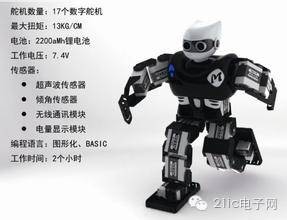According to statistics from market research institutions, the market value of China's industrial robots reached US$1.3 billion in 2015, and will maintain a 20% annual compound growth (CAGR), reaching US$3.3 billion by 2020.
In 2015, China’s industrial robot sales accounted for 13% of the world's total, and by 2020 it will reach 25%. The acquisition of Cook by the beautiful flower is probably also a good development momentum for industrial robots.
An industrial robot belonging to the intelligent robot, intelligent robot developed rapidly, following Xiaobian below to learn about the three key technologies of intelligent robot used in it.
First, multi-sensor information fusion
Multi-sensor information fusion technology is a hot research topic in recent years. It combines control theory, signal processing, artificial intelligence, probability and statistics to provide robots with tasks in a variety of complex, dynamic, uncertain and unknown environments. A technical solution.

The key issues of data fusion are model design and fusion algorithms. Data fusion models mainly include functional models, structural models and mathematical models. The functional model starts from the fusion process, describes the main functions and databases involved in data fusion, and the interaction process between the components of the system during data fusion. The structural model starts from the composition of data fusion and describes the software and hardware of the data fusion system. Composition, related data flow, human-machine interface between system and external environment; mathematical model is data fusion algorithm and integrated logic, the algorithm mainly includes distribution detection, spatial fusion, attribute fusion, situation assessment and threat estimation algorithm, etc. The aspects are introduced separately.
1. Functional model of information fusion
At present, many scholars have proposed the general functional model of information fusion system from different angles. The most authoritative is DFS (Data Integration Expert of C3I Technical Committee (TPC3) under the US Armed Forces Government-Laboratory Joint Committee (JDL). Group) proposed functional model.
The model divides data fusion into three levels. Level 1 is single-source or multi-source processing, mainly digital processing, tracking correlation and correlation; level 2 is a collection of evaluation target estimates, and their relationship to each other to assess the whole situation; level 3 uses a system A priori set of targets to test the assessment.
2. Structural model of information fusion
The structural model of data fusion has a number of different classification methods, one of which is classified according to the extent to which the sensor data has been processed before being sent to the fusion processing center. Under this classification standard, the fusion structure is divided into sensor-level data fusion, central-level data fusion and hybrid fusion, and the fusion structure can be classified according to the resolution of the data processing process. In this case, the fusion structure is a pixel level, feature level, and decision level fusion.
3. Mathematical model of multi-sensor information fusion
The method of information fusion involves many aspects of theory and technology, such as signal processing, estimation theory, uncertainty theory, pattern recognition, optimization techniques, fuzzy mathematics and neural networks.
Currently, these methods are broadly divided into two categories: random class methods and artificial intelligence methods.
Inclined Operating Control Desk
Inclined Operating Control Desk,Security Operation Console Desk,Tilted Operating Control Desk,Sloped Operating Control Desk
Huaian Qiangsheng Cabinet Co., Ltd. , https://www.qscontrolcabinet.com
